Content
- 1 Rules for growing melons in polycarbonate greenhouses
Rules for growing melons in polycarbonate greenhouses
Juicy, aromatic melon native to southern countries. But what to do if the southern beauty does not grow in a harsh climate, for example, in Siberia? The solution has been found, because it can be grown in polycarbonate greenhouses.
Advantage of growing melon in polycarbonate greenhouse
It is much easier to grow melon outdoors than in a greenhouse, since it is necessary to create and constantly maintain favorable conditions for the growth and development of the fruit:
- observe the temperature regime
- monitor lighting
- adhere to the required air humidity.
A big plus of growing melons in a greenhouse is a year-round harvest.
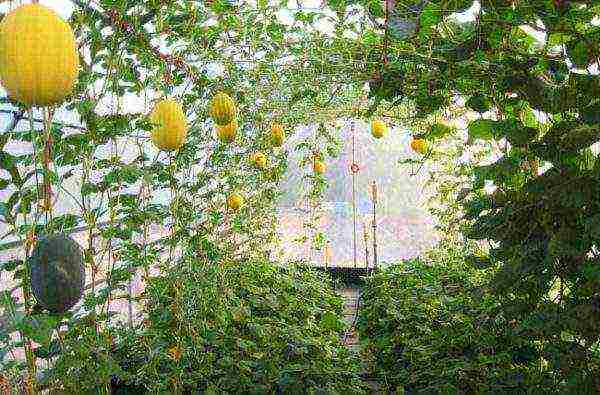
How to choose the right landing site?
Preparing the garden and soil is the key to a good harvest.
Bed formation:
- The top layer of soil is removed by 20 cm
- Further, branches, expanded clay and crushed stone are laid in the received trench
- Hay or mowed grass is lined on top of the drain
- Then sprinkle with humus, which is sprinkled with fallen leaves or sawdust
- Cover everything up with earth
- Mineral fertilizers and lime can be added to the soil (if the soil is acidic and heavy).
- The made bed is spilled with warm water and covered with a dark covering material to quickly warm the soil.
In this way, a nutritious and warm bed is obtained in which the culture will grow and bear fruit well.
How to choose the right greenhouse?
In order for the melon to grow fragrant and tasty, and the bush to bring a rich harvest, it is necessary to prepare a place for its growth.
A greenhouse is not suitable for this purpose, since it is small in size.
The greenhouse must be at least 2 meters high, since a berry is a melon crop, which, as it grows, winds in an upright position along a trellis, and if you take a smaller structure, then there may not be enough space for full development.
With a short day light, specialized lamps are installed.The plant can tolerate a slight drought, but with high humidity it can get sick with fungal diseases.
Since melon is a southern plant, for full growth and timely ripening, heating devices are installed in the greenhouse.
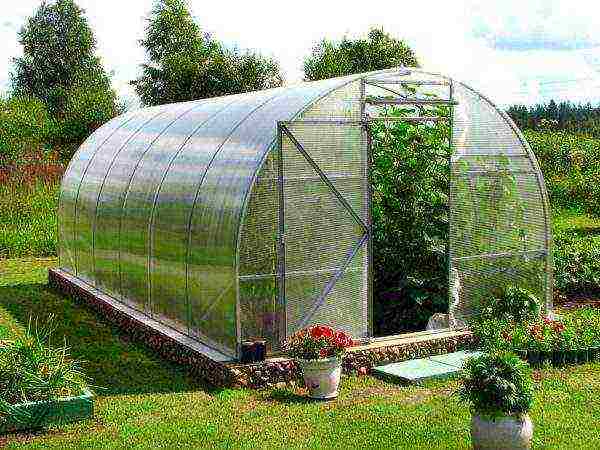
Selection and purchase of seeds
Before planting a berry, you should approach the choice of seeds with serious responsibility. What should you pay attention to?
- Ripening terms
- Taste qualities
- Resistance to temperature changes
- Yield level
The best varieties for growing in a greenhouse
Such varieties are ideal as:
- Canaria
- Sharena
- Augen
- Collective farmer
- Galia
They have a sweet, full-bodied flavor and are ideal for indoor growing.
To grow fruits in a harsh climate, you need to purchase early ripening varieties:
- Golden
- Gribovskaya
- Tobolin
- Siberian early ripening
- Zolotinka
To obtain an earlier harvest, these varieties must be planted in seedlings.
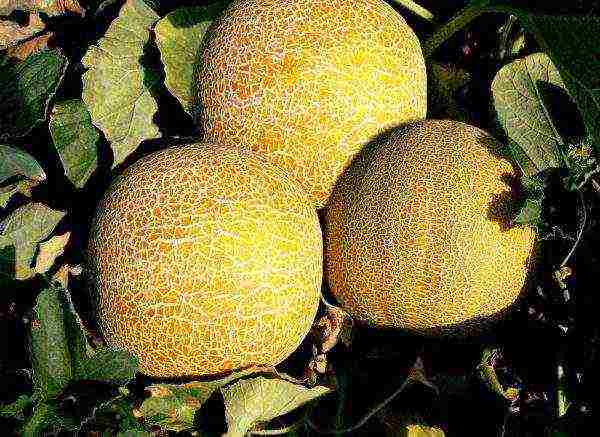
Planting and leaving
In a greenhouse, a berry can only be grown by seedling. To get strong seedlings, you must follow simple rules:
- The seeds are germinated in separate pots with a diameter of 14 cm.
- When growing seedlings, you need to withstand temperature regime: during the day - 20-26 degrees, at night - 18 degrees.
- Before planting, young seedlings are pre-hardened, for this the night temperature is reduced to 16 degrees.
- Seedlings grow well on southern windows; in cloudy weather, additional lighting is needed with the help of a phytolamp.
- Watering the seedlings is carried out with warm, settled water, after the top layer of the earth has dried out.
- Seedlings are planted in prepared holes, which are previously shed with warm water. A liter of water per hole.
- Two seedlings are planted in one hole at once and as they grow, their lashes are distributed in different directions.
- Seedlings are planted depending on the place of residence, approximately in mid-May, after 40 cm in a row.
Plant care consists of:
- In compliance with the temperature regime
- To provide additional light
- Irrigated with warm water
- In hand pollination
Organization of temperature and humidity conditions
In order for the plant to grow well, it needs to provide the proper temperature and humidity conditions.
When growing melons in a greenhouse, the main thing is to observe the temperature schedule:
- After planting seedlings in a permanent place, the air temperature is reduced to 20 degrees, for better plant survival.
- During fruit formation, the temperature must also be lowered to 22 during the day and 18 at night.
Humidity also plays an important point:
- When growing seedlings, the humidity should be - 21%
- During the formation of flowers and fruits - 37%
- With the growth of fruits - 32%
- At the time of ripening - 10%
Air humidity should be 60-70%, when fruits ripen, the plant needs dry air.
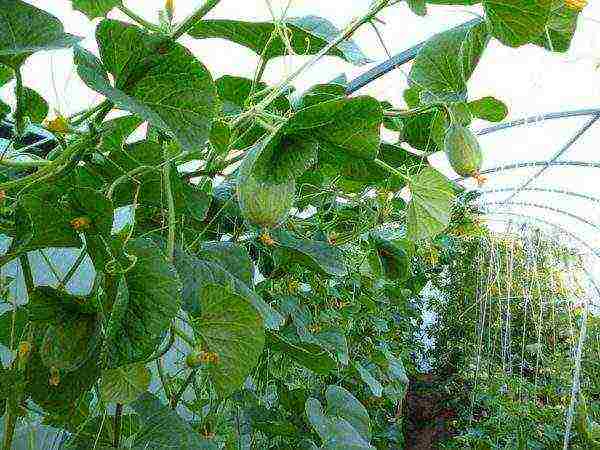
Lighting
In order for the melon to grow juicy and tasty, it is necessary to provide the plant with 12 hours of daylight. If there is not enough light, the plant does not develop well. For this, special lamps are installed to extend daylight hours.
Longer lighting has a detrimental effect on the plant, flowering occurs with a delay, which leads to late fruiting.
Necessary equipment for fruit care
If there is not enough light and to maintain the required temperature regime, additional equipment can be installed.
As a source of artificial lighting, you can use:
- Phytolamps
- Fluorescent lamps
- LED bulbs
- Metal halide lamps
For additional heating, you can apply:
- Air heaters
- Convectors

Pollination
When growing fruits in greenhouse conditions, it is necessary to carry out artificial pollination.
As soon as the flowers of the female type bloom, they bloom as a rule in the morning, you must immediately start pollination. To do this, the male flower is stripped down to the stamens and the pistil of the female flower is touched. After that, it is important to check for pollen on the pistil. If there are doubts about pollination, it is necessary to repeat the procedure, but with a different male flower.
If you do not carry out manual pollination, then the formation of the fruit will not occur.
In hot weather, it is necessary to periodically ventilate the greenhouse. To attract pollinating insects, female flowers are sprayed with sugar syrup, a container with a honey solution is installed.
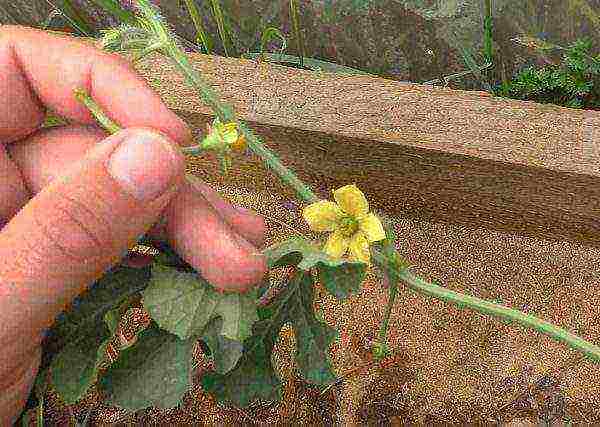
Watering bushes
It is necessary to water the plant only with warm water (30-33 degrees); when watering with cold water, rotting of the root system can occur and the plant will die.
With the formation of fruits, watering is increased.
Watering should be moderate. The root system of the culture is pivotal and goes deep into the soil, thus, the melon receives additional moisture from the bowels of the earth. Due to the overflow, the plant begins to ache, the fruits rot and crack.
Lack of water is checked for foliage. If the leaves are drooping, then the plant needs additional watering.
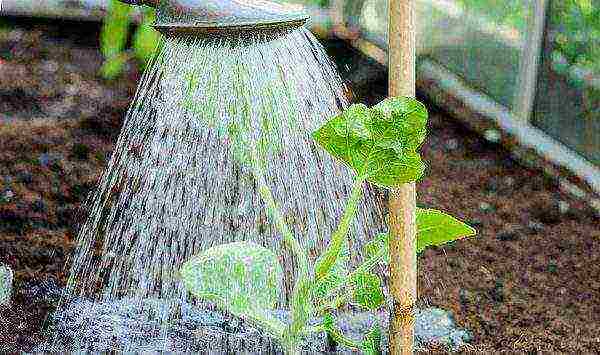
Possibility of joint planting of seedlings with other plants
Melons can be planted with other crops such as:
- Pepper
- Cucumbers
- Eggplant
Experienced gardeners grow berries in separate greenhouses, since the culture needs a certain temperature (about 30 degrees) and low air humidity. If the neighborhood is inevitable, it is advisable to plant seedlings according to a certain pattern.
With a short daylight hours, artificial lighting is installed.
The plant can withstand a slight drought, but with high humidity it can get sick with fungal diseases.
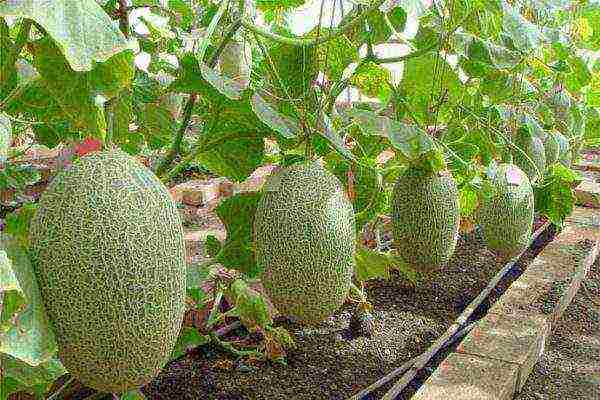
Harvesting
Melon reaches technical maturity, with proper care, in early August. Ripeness can be determined by appearance. The tail of a ripe melon forms ring cracks, and the fruit itself exudes an unforgettable aroma.
The fruit must be lightly squeezed in the hands and if it is springy inside, then it is ready to eat.The fruits are transported in boxes, with each berry wrapped in wax paper, so that they do not come into contact with each other and do not rot.
If you set yourself a goal, grow a melon in a greenhouse, then you need to properly care for it, form fruits. The fruit without damage, plucked in an immature state, ripens quickly in a dry and warm room, without losing all its useful qualities and unique taste.


